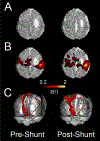Neonatal brain injury and aberrant connectivity
- PMID: 30059733
- PMCID: PMC6289815
- DOI: 10.1016/j.neuroimage.2018.07.057
Neonatal brain injury and aberrant connectivity
Abstract
Brain injury sustained during the neonatal period may disrupt development of critical structural and functional connectivity networks leading to subsequent neurodevelopmental impairment in affected children. These networks can be characterized using structural (via diffusion MRI) and functional (via resting state-functional MRI) neuroimaging techniques. Advances in neuroimaging have led to expanded application of these approaches to study term- and prematurely-born infants, providing improved understanding of cerebral development and the deleterious effects of early brain injury. Across both modalities, neuroimaging data are conducive to analyses ranging from characterization of individual white matter tracts and/or resting state networks through advanced 'connectome-style' approaches capable of identifying highly connected network hubs and investigating metrics of network topology such as modularity and small-worldness. We begin this review by summarizing the literature detailing structural and functional connectivity findings in healthy term and preterm infants without brain injury during the postnatal period, including discussion of early connectome development. We then detail common forms of brain injury in term- and prematurely-born infants. In this context, we next review the emerging body of literature detailing studies employing diffusion MRI, resting state-functional MRI and other complementary neuroimaging modalities to characterize structural and functional connectivity development in infants with brain injury. We conclude by reviewing technical challenges associated with neonatal neuroimaging, highlighting those most relevant to studying infants with brain injury and emphasizing the need for further targeted study in this high-risk population.
Keywords: Brain injury; Functional connectivity; Infant; Magnetic resonance imaging; Prematurity; Structural connectivity.
Copyright © 2018 Elsevier Inc. All rights reserved.
Conflict of interest statement
Figures







References
-
- Abrol A, Damaraju E, Miller RL, Stephen JM, Claus ED, Mayer AR, & Calhoun VD (2017). Replicability of time-varying connectivity patterns in large resting state fMRI samples. Neuroimage, 163, 160–176. doi:10.1016/j.neuroimage.2017.09.020 - DOI - PMC - PubMed
-
- Adams-Chapman I, Hansen NI, Stoll BJ, & Higgins R (2008). Neurodevelopmental Outcome of Extremely Low Birth Weight Infants With Posthemorrhagic Hydrocephalus Requiring Shunt Insertion. Pediatrics, 121(5), e1167–e1177. doi:10.1542/peds.2007-0423 - DOI - PMC - PubMed
-
- Adams-Chapman I, Hansen NI, Stoll BJ, Higgins R, & Network NR (2008). Neurodevelopmental outcome of extremely low birth weight infants with posthemorrhagic hydrocephalus requiring shunt insertion. Pediatrics, 121(5), e1167–1177. doi:10.1542/peds.2007-0423. Epub 2008 Apr 7. - DOI - PMC - PubMed
-
- Alcauter S, Lin W, Keith Smith J, Gilmore JH, & Gao W (2013). Consistent Anterior-Posterior Segregation of the Insula During the First 2 Years of Life. Cereb Cortex. doi:10.1093/cercor/bht312 - DOI - PMC - PubMed
-
- Alcauter S, Lin W, Smith JK, Short SJ, Goldman BD, Reznick JS, … Gao W (2014). Development of thalamocortical connectivity during infancy and its cognitive correlations. J Neurosci, 34(27), 9067–9075. doi:10.1523/JNEUROSCI.0796-14.2014 - DOI - PMC - PubMed
Publication types
MeSH terms
Grants and funding
LinkOut - more resources
Full Text Sources
Other Literature Sources
Medical

